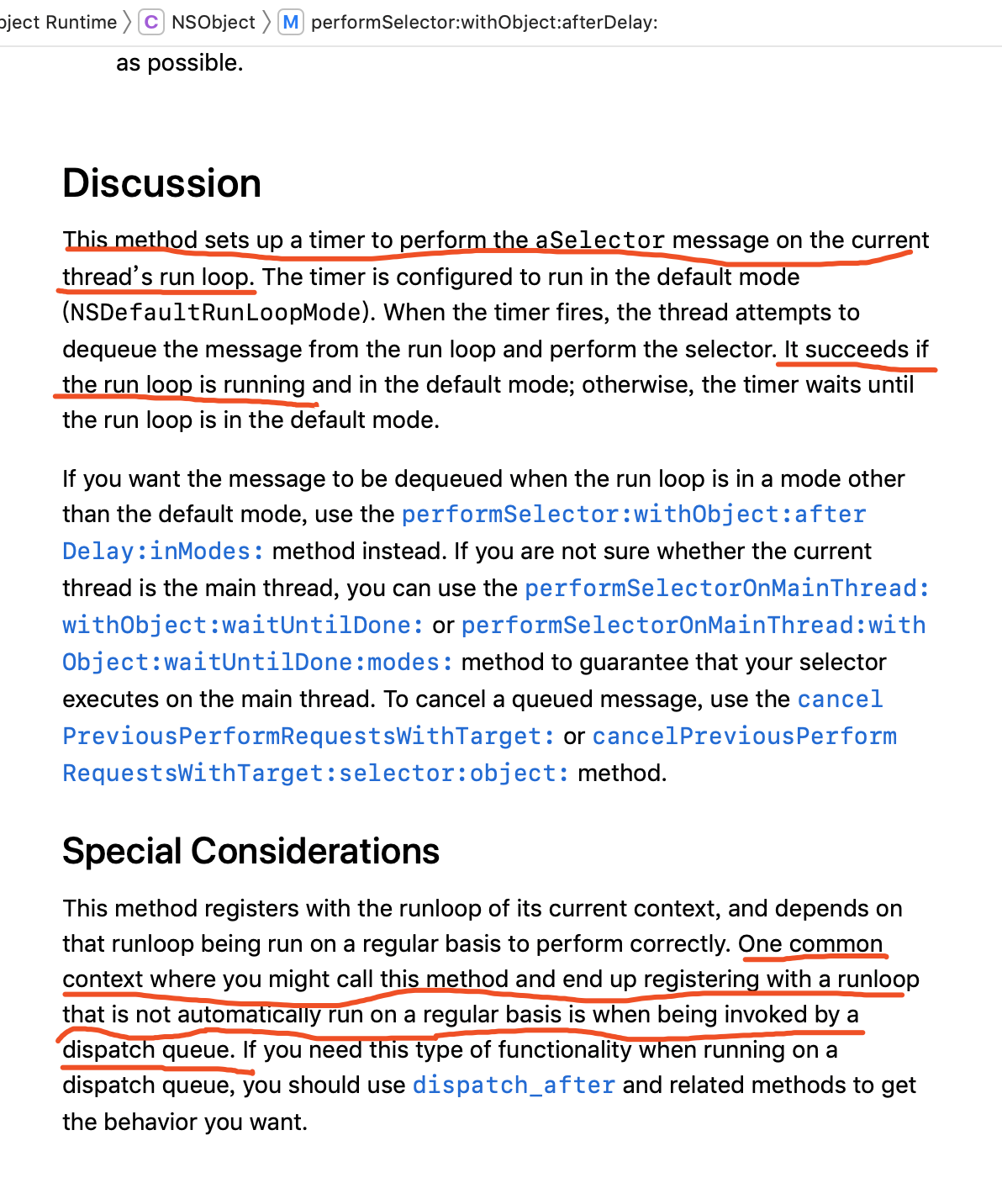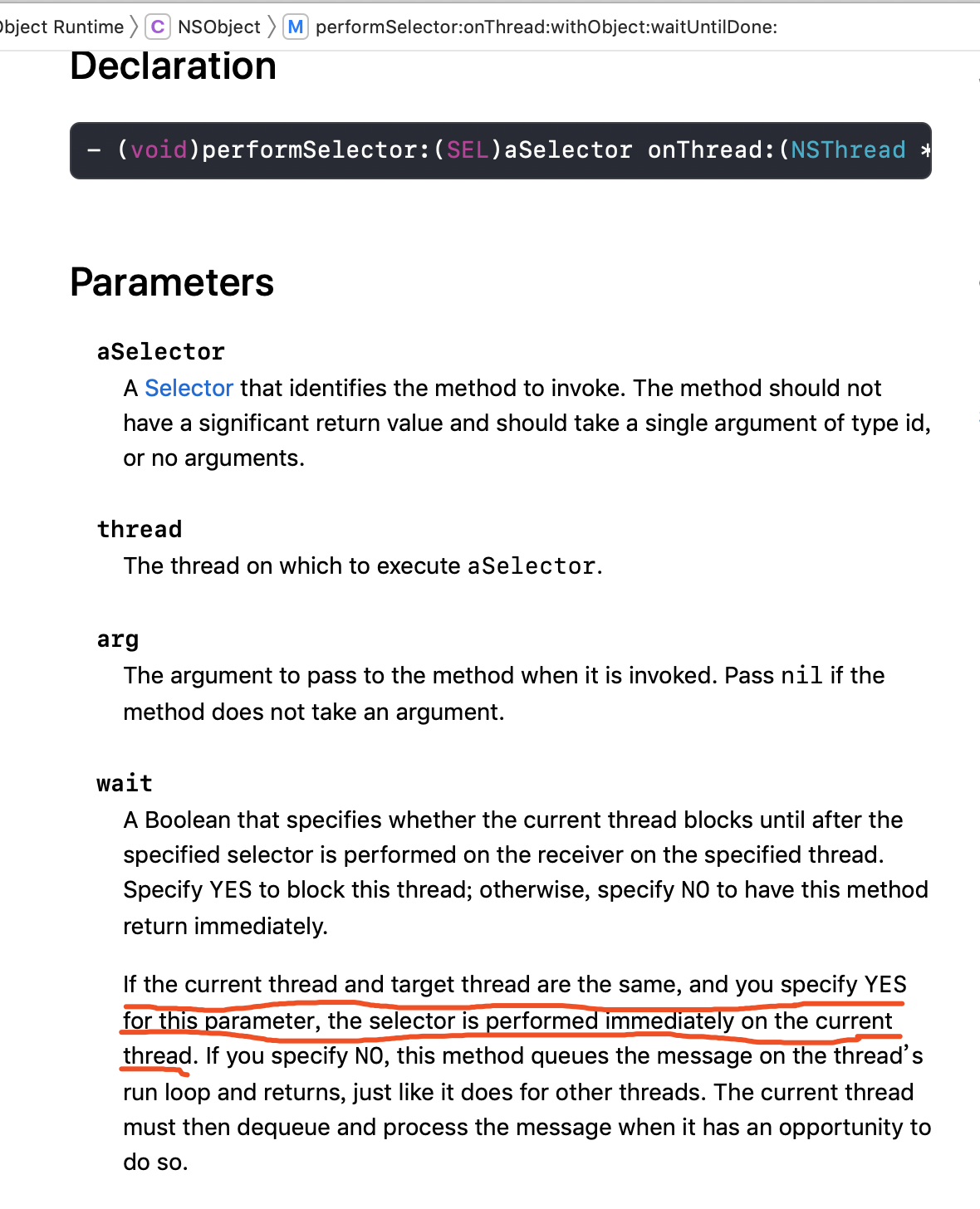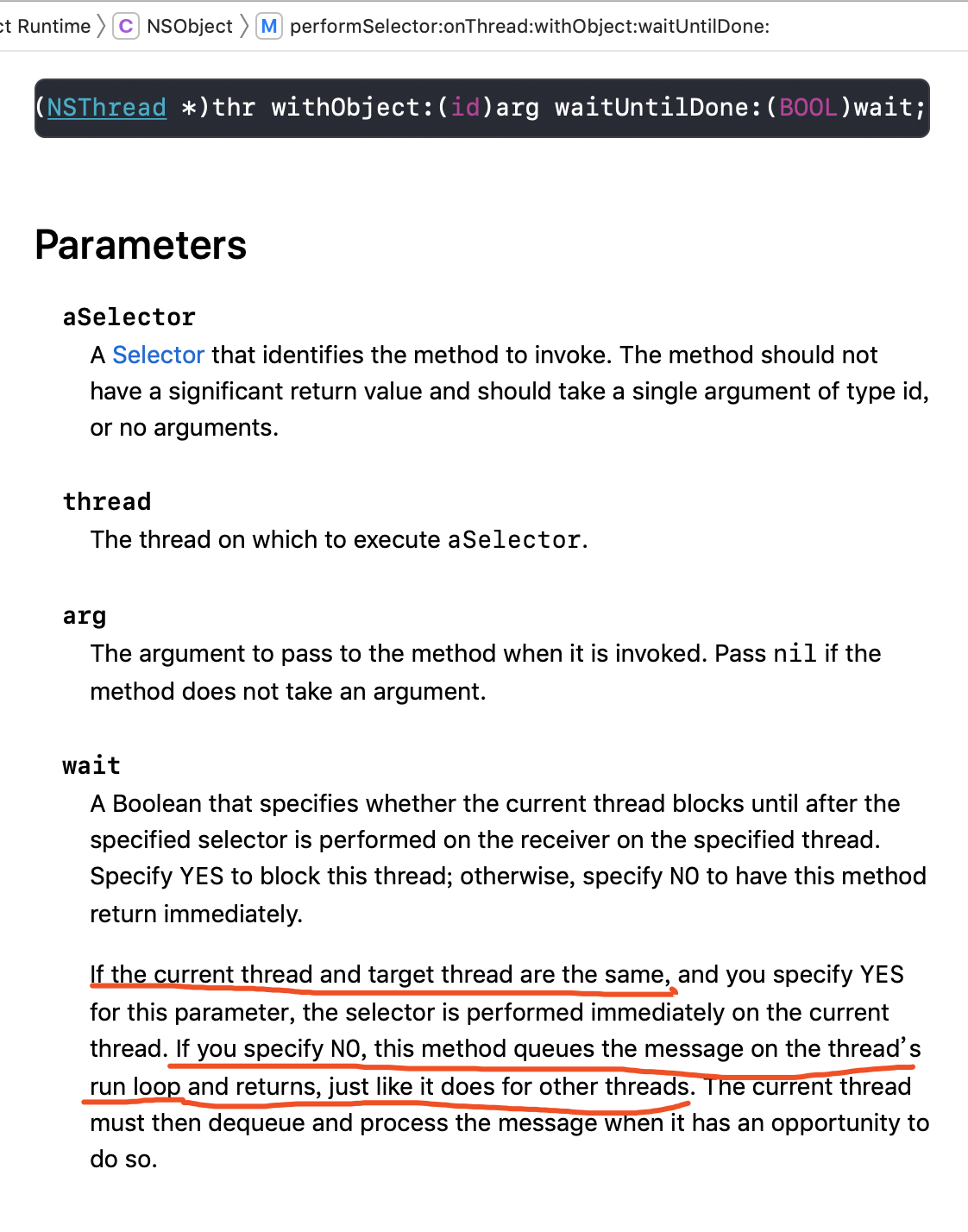考虑以下代码,最终会输出什么?
例子①:
1 | - (void)viewDidLoad |
- 输出结果:
1,2,3,4 - 原因:因为
performSelector:withObject:会在当前线程立即执行指定的selector方法。
例子②:
1 | - (void)viewDidLoad |
- 输出结果:
1,2,4 - 原因:因为
performSelector:withObject:afterDelay:实际是往 RunLoop 里面注册一个定时器,而在子线程中,RunLoop 是没有开启(默认)的,所有不会输出 3。官网 API 作如下解释:
例子③:
1 | - (void)viewDidLoad |
- 输出结果:
1,2,3,4 - 原因:由于
[[NSRunLoop currentRunLoop] run];会创建的当前子线程对应的 RunLoop 对象并启动了,因此可以执行test方法;并且test执行完后,RunLoop 中注册的定时器已经无效,所以还可以输出 4 (对比 例子⑥例子)。
例子④:
1 | - (void)viewDidLoad |
输出结果:
1,2,3,4原因:因为
performSelector:onThread:withObject:waitUntilDone:会在指定的线程执行,而执行的策略根据参数wait处理,这里传YES表明将会立即阻断 指定的线程 并执行指定的selector。官网 API 解释如下:
例子⑤:
1 | - (void)viewDidLoad |
输出结果:
1,2,4原因:因为
performSelector:onThread:withObject:waitUntilDone:会在指定的线程执行,而执行的策略根据参数wait处理,这里传NO表明不会立即阻断 指定的线程 而是将selector添加到指定线程的 RunLoop 中等待时机执行。(该例子中,子线程 RunLoop 没有启动,所有没有输出 3)官网 API 解释如下:
例子⑥:
1 | - (void)viewDidLoad |
- 输出结果:
1,2,3 - 原因:由于
[[NSRunLoop currentRunLoop] run];已经创建的当前子线程对应的 RunLoop 对象并启动了,因此可以执行test方法;但是test方法执行完后,RunLoop 并没有结束(使用这种启动方式,RunLoop 会一直运行下去,在此期间会处理来自输入源的数据,并且会在 NSDefaultRunLoopMode 模式下重复调用runMode:beforeDate:方法)所以无法继续输出 4。
例子⑦
1 | - (void)viewDidLoad |
- 输出结果:
1,2,3 - 原因:由于
[[NSRunLoop currentRunLoop] runUntilDate:[NSDate distantFuture]];已经创建的当前子线程对应的 RunLoop 对象并启动了,因此可以执行test方法;但是test方法执行完后,RunLoop 并没有结束(使用这种启动方式,可以设置超时时间,在超时时间到达之前,runloop会一直运行,在此期间runloop会处理来自输入源的数据,并且会在 NSDefaultRunLoopMode 模式下重复调用runMode:beforeDate:方法)所以无法继续输出 4。
例子⑧:
1 | - (void)viewDidLoad |
- 输出结果:
1,2,3,4 - 原因:由于
[[NSRunLoop currentRunLoop] runMode:NSDefaultRunLoopMode beforeDate:[NSDate distantFuture]];已经创建的当前子线程对应的 RunLoop 对象并启动了,因此可以执行test方法;而且test方法执行完后,RunLoop 立刻结束(使用这种启动方式 ,RunLoop 会运行一次,超时时间到达或者第一个 input source 被处理,则 RunLoop 就会退出)所以可以继续输出 4。
小结:
常用
performSelector方法常用的
perform,是 NSObject.h 头文件下的方法:1
2
3- (id)performSelector:(SEL)aSelector;
- (id)performSelector:(SEL)aSelector withObject:(id)object;
- (id)performSelector:(SEL)aSelector withObject:(id)object1 withObject:(id)object2;可以 delay 的
perform,是 NSRunLoop.h 头文件下的方法:1
2- (void)performSelector:(SEL)aSelector withObject:(nullable id)anArgument afterDelay:(NSTimeInterval)delay inModes:(NSArray<NSRunLoopMode> *)modes;
- (void)performSelector:(SEL)aSelector withObject:(nullable id)anArgument afterDelay:(NSTimeInterval)delay;可以 指定线程 的
perform,是 NSThread 头文件下的方法:1
2
3
4
5- (void)performSelectorOnMainThread:(SEL)aSelector withObject:(nullable id)arg waitUntilDone:(BOOL)wait modes:(nullable NSArray<NSString *> *)array;
- (void)performSelectorOnMainThread:(SEL)aSelector withObject:(nullable id)arg waitUntilDone:(BOOL)wait;
- (void)performSelector:(SEL)aSelector onThread:(NSThread *)thr withObject:(nullable id)arg waitUntilDone:(BOOL)wait modes:(nullable NSArray<NSString *> *)array;
- (void)performSelector:(SEL)aSelector onThread:(NSThread *)thr withObject:(nullable id)arg waitUntilDone:(BOOL)wait;
- (void)performSelectorInBackground:(SEL)aSelector withObject:(nullable id)arg;
RunLoop 退出方式:
- 使用
- (void)run;启动,RunLoop 会一直运行下去,在此期间会处理来自输入源的数据,并且会在 NSDefaultRunLoopMode 模式下重复调用runMode:beforeDate:方法; - 使用 **
- (void)runUntilDate:(NSDate *)limitDate;**启动,可以设置超时时间,在超时时间到达之前,RunLoop 会一直运行,在此期间 RunLoop 会处理来自输入源的数据,并且也会在 NSDefaultRunLoopMode 模式下重复调用runMode:beforeDate:方法; - 使用 **
- (void)runMode:(NSString *)mode beforeDate:(NSDate *)limitDate;**启动,RunLoop 会运行一次,超时时间到达或者第一个 input source 被处理,则 RunLoop 就会退出。
- 使用
更多关于 NSRunLoop的退出方式 可以看这篇博文

